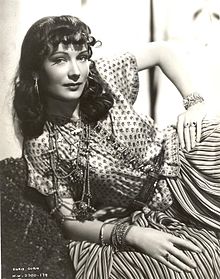Sigrid Gurie
Sigrid Gurie | |
|---|---|
 Sigrid Gurie in Algiers (1938) | |
| Born | Sigrid Guri Haukelid May 18, 1911 Brooklyn, New York, U.S. |
| Died | August 14, 1969 (aged 58) Mexico City, Mexico |
| Occupation | Actress |
| Years active | 1937–1950 |
| Spouses | Thomas Stewart
(m. 1935; div. 1938)Dr. Lawrence Spangard
(m. 1939; div. 1948)Lynn Abbott
(m. 1958; div. 1961) |
| Relatives | Knut Haukelid (brother) |
Sigrid Gurie (born Sigrid Guri Haukelid; May 18, 1911 – August 14, 1969) was a Norwegian-American actress from the late 1930s to early 1940s.[1][2]
Early life
Gurie was born in Brooklyn, New York. Her father was a civil engineer who worked for the New York City Subway from 1902 to 1912. As she and her twin brother, Knut, were born in the United States, the twins held dual Norwegian-American citizenship. In 1914, the family returned to Norway. Sigrid subsequently grew up in Oslo and was educated in Norway, Sweden, and Belgium.[3]
In 1935, Gurie married Thomas Stewart of California; she filed for divorce in 1938.[4] Her brother became a noted member of the Norwegian resistance movement during World War II. Knut Haukelid died at age 82 in 1994.[5]
Career
In 1936, Gurie arrived in Hollywood. Film magnate Sam Goldwyn reportedly took credit for discovering her, promoting his discovery as "the Norwegian Garbo" and billed her as "the siren of the fjords".[6][4] When the press discovered Gurie's birth in Flatbush, Goldwyn then claimed "the greatest hoax in movie history."[7]
Gurie performed well in the supporting role of Ines in Algiers (1938), but did less well in Universal’s Three Faces West (1940), the New York Times deeming her effort “less than adequate.”[8] Gurie accepted the lead role in Voice in the Wind (1944), but the production was panned by critics.[9] She had a minor role in the classic Norwegian film Kampen om tungtvannet (1948). The movie was based principally on the book Skis Against the Atom which was written by her brother,[10] Knut Haukelid, a noted saboteur and member of the Norwegian resistance against German occupation in World War II.
Later years and death
In the late 1940s she attended the Kann Art Institute, operated in West Hollywood by abstract artist Frederick I. Kann (1886–1965). She studied oils and portraiture. Among her works were landscapes, portraits and pen and ink sketches.
From 1961 to 1969 she lived in San Miguel de Allende, Mexico, where she continued painting, and was also designing jewelry for Royal Copenhagen in Denmark.
She entered the hospital in Mexico City on an emergency basis for a recurring kidney problem, then developed a blood clot that passed through her lungs, which led to her death.
Filmography
| Year | Title | Role | Notes |
|---|---|---|---|
| 1937 | The Road Back | Soldier's wife | Uncredited |
| 1938 | Algiers | Ines | |
| The Adventures of Marco Polo | Princess Kukachin | ||
| 1939 | The Forgotten Woman | Anne Kennedy | |
| Rio | Irene Reynard | ||
| 1940 | Three Faces West | Leni "Lenchen" Braun | |
| Dark Streets of Cairo | Ellen Stephens | ||
| 1944 | Voice in the Wind | Marya | |
| Enemy of Women | Magda Quandt | ||
| 1948 | Kampen om tungtvannet (released internationally as Operation Swallow: The Battle for Heavy Water) |
||
| Sword of the Avenger | Maria Louisa | ||
| Sofia | Linda Carlsen | ||
| 1950 | The Du Pont Story | Sophie du Pont |
Notes
- ^ "Sigrid Gurie". Store norske leksikon. Retrieved September 11, 2015.
- ^ Wollstein, 1994 pp. 136-142: Biography
- ^ "Sigrid Gurie: Norwegian American Actress". lawzone.com. Retrieved September 11, 2015.
- ^ a b ""The Flower of Flatbush" Makes Good: Sigrid Gurie loves Gary Cooper in "Marco Polo"". Life. April 18, 1938. p. 29. Retrieved November 28, 2011.
- ^ "WW II 'Hero of Telemark' Knut Haukelid dead at 82". Santa Cruz Sentinel. California, Santa Cruz. Associated Press. March 11, 1994. p. D - 6. Retrieved October 21, 2018 – via Newspapers.com.

- ^ Wollstein, 1994 p. 136: “...Goldwyn’s ‘Siren of the Fiords…Goldwyn, like everybody else in Hollywood, wanted another Garbo.”
- ^ Wollstein, 1994 p. 139: See here for “hoax” quote by Goldwyn. Nothing in Wollstein that indicates “scapegoating” of Gurie. And p. 141: “...Goldwyn came to regret promoting an unknown quantify like Segrid Gurie.”
- ^ Wollstein, 1994 p. 140
- ^ Wollstein, 1994 p. 140: Variety described the film as “pointless.”
- ^ "Knut Haukelid". Store norske leksikon. Retrieved September 11, 2015.
References
- Wollstein, Hans J. 1994. Strangers in Hollywood: The History of Scandinavian Actors in American Films, 1910 to World War II. The Scarecrow Press, Filmmakers series no. 43. Anthony Slide, editor ISBN 0-8108-2938-X
External links
- Sigrid Gurie at IMDb
- Sigrid Gurie at AllMovie
- Sigrid Gurie at the TCM Movie Database
- Articles with short description
- Short description is different from Wikidata
- Use mdy dates from January 2022
- Use American English from January 2022
- All Wikipedia articles written in American English
- Articles with hCards
- Articles needing additional references from April 2020
- All articles needing additional references
- Commons category link from Wikidata
- TCMDb name template using numeric ID from Wikidata
- Articles with FAST identifiers
- Articles with ISNI identifiers
- Articles with VIAF identifiers
- Articles with BNE identifiers
- Articles with BNF identifiers
- Articles with BNFdata identifiers
- Articles with GND identifiers
- Articles with J9U identifiers
- Articles with LCCN identifiers
- Articles with NKC identifiers
- Articles with KULTURNAV identifiers
- 1911 births
- 1969 deaths
- Actresses from Brooklyn
- American people of Norwegian descent
- 20th-century American actresses
- Norwegian twins
- American expatriates in Mexico